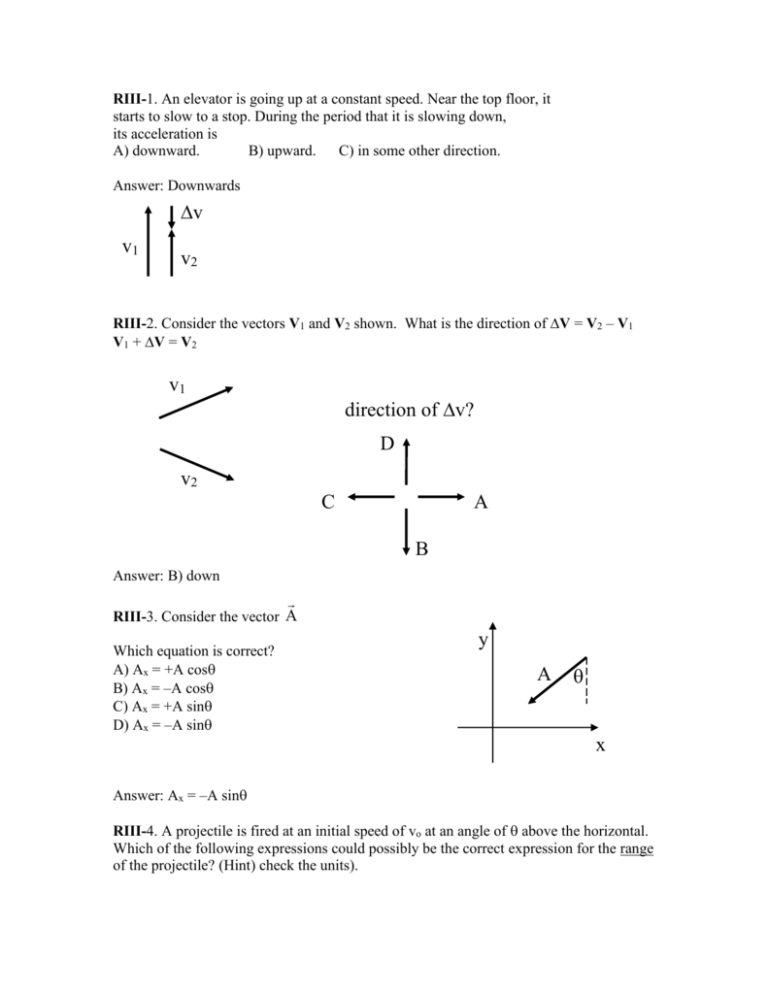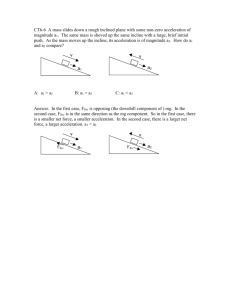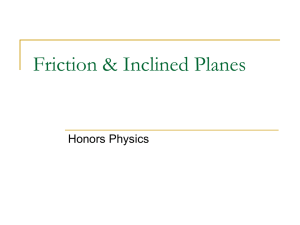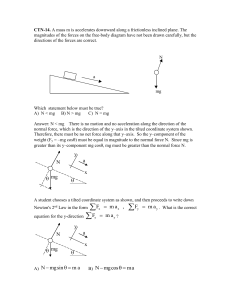ExamIIRevAnsFa06
advertisement

RIII-1. An elevator is going up at a constant speed. Near the top floor, it starts to slow to a stop. During the period that it is slowing down, its acceleration is A) downward. B) upward. C) in some other direction. Answer: Downwards v v1 v2 RIII-2. Consider the vectors V1 and V2 shown. What is the direction of V = V2 – V1 V1 + V = V2 v1 direction of v? D v2 C A B Answer: B) down RIII-3. Consider the vector A Which equation is correct? A) Ax = +A cos B) Ax = –A cos C) Ax = +A sin D) Ax = –A sin y A x Answer: Ax = –A sin RIII-4. A projectile is fired at an initial speed of vo at an angle of above the horizontal. Which of the following expressions could possibly be the correct expression for the range of the projectile? (Hint) check the units). A) x 2g v0 tan vo2 C) x sin 2 g B) x 2g 2 vo sin(2) D) x g sin 2 vo2 Answer: C) only this expression has the units of distance RIII-5. A plane in horizontal flight moving at constant velocity drops a heavy package while approaching the border of a kingdom. Which crosses the border first? (As usual, assume that air resistance is negligible.) A) the plane B) the package C) both cross at the same instant v = constant border Answer: Both cross at the same instant. RIII-6. A boy of mass M = 50 kg pushes on a baby carriage of mass M/5 = 10 kg. The force on the carriage from the boy has magnitude FonCarriage. The force on the boy from the carriage handle has magnitude FonBoy. How do the forces compare? A) FonCarriage = 5 FonBoy C) FonCarriage = FonBoy B) FonCarriage = 0.2 FonBoy Answer: By Newton's third law, the forces must be the same magnitude (and opposite in the direction). RIII-7. A heavy–duty truck pulling a light trailer is accelerating forward. How does the force on the truck FonTruck from the trailer compare to the force on the trailer FonTrailer from the truck? a A) FonTruck > FonTrailer B) FonTrailer > FonTruck C) FonTrailer = FonTruck Answer: By Newton's 3rd Law, FonTrailerfromTruck = FonTruckfromTrailer RIII-8. In the 1600's, Otto Van Güricke, a physicist in Magdeburg, fitted two hollow bronze hemispheres together and removed the air from the resulting sphere with a pump. Two eight-horse teams could not pull the spheres apart, even though the hemispheres fell apart when air was re-admitted. Suppose von Güricke had tied both teams of horses to one side and bolted the other side to a heavy tree trunk. In this case the tension in the rope would be... A) twice B) exactly the same as C) half what it was before. Answer: Twice. This is not a Newton's 3rd law situation. The force from 16 horses is twice the force from 8 horses. [Putting 8 horses on each side was silly (or entertaining). He could have gotten the same tension with 8 horses on one side only and the other side tied to a tree trunk.] RIII-9. A box of mass m is sitting at rest on a horizontal table. The magnitudes of the normal force N and the weight mg are equal: N = mg. True(A) or false(B): The forces N and mg are a Newton's Third Law action–reaction pair. Answer: False. Newton's III law force pairs always involve a pair of forces acting on different objects. Here, the forces N and mg both act on the same object (the box). RIII-10. A crate of mass m rests on a rough surface with coefficient of kinetic friction K. A horizontal force F is applied which maintains a constant acceleration a. What is the size of that force? a m F A) F = ma + mg C) ma E) None of these. B) F = ma – mg D) (ma + mg)/ Answer: F = ma + mg, since Fnet = +F – Kmg = ma RIII-11. A crate of mass m is accelerated to the left with a string at an angle q above the horizontal. The coefficient of kinetic friction is K. The coordinate system has been chosen as shown. What is the correct y–equation? y F a A) F N mg 0 C) Fsin N mg 0 E) None of these x K B) Fcos K N ma D) Fcos N mg 0 Answer: Fsin N mg 0 (X–equation would be Fcos K N ma ) RIII-12. A stationary crate is pulled to the left with a horizontal cord. The tension in the cord is T and the crate is not moving. The coefficient of state friction is S. Which of the following statements must be true? T S I. The magnitude of the force of friction is T. II. The magnitude of the force of friction is SN. III.The magnitude of the force of friction is Smg. A) All 3 statements must be true. B) All 3 statements are not necessarily true. C) Only 1 of the 3 statements must be true. D) Only 2 of the 3 statements must be true. Answer: Only 1 statement (Ffric = T) must be true. Since the crate is stationary, the force to the left (T) must be exactly cancelled by the force to the right (Ffric). N fFric T mg Neither statements II or III must be true. SN=Smg is the maximum possible force of static friction. The force of friction can be less than this maximum. RIII-13. Consider the two equations in two unknowns x and y) 3x – y = 0 What is x? A) 2 B) 3 x+y= 2 C) 1/4 D) 4 E) None of these Answer: None of these: x = 1/2 RIII-14. A rider in a "barrel of fun" finds herself stuck with her back to the wall. The free-body diagram is shown. Is the following statement definitely true for this situation? sN=mg A) Yes, it is certainly true. B) No, it might not be true. Answer: No, it might not be true. sN is the MAXIMUM possible force of static friction. The actual force may be less than this max value. It is definitely true that Ffric = mg in this case (since the person is not sliding along the wall). But it is not necessarily true that Ffric = sN. RIII-15. The free-body diagram for a car rounding a banked curve is shown. The car is going so fast that it is about to slip. The coordinate system has been chosen. y a N x SN mg What is the correct y-equation? A) N sin + sN cos – mg = 0 B) N – sN sin – mg cos = 0 C) N – mg cos = 0 D) N cos – sN sin – mg = 0 E) None of these Answer: N cos – sN sin – mg = 0 RIII-16. What is the magnitude of the force of gravity exerted on the Earth by an apple that is falling from a tree to the ground? A) mg B) > mg C) < mg m Answer: mg By Newton's third law, the force of gravity on the Earth by the apple is the same size as the force on the apple by the Earth, and this is mg RIII-17. For a small mass m on the surface of a planet of mass M and radius R, is it GMm = mg ? always true that R2 A) Yes, this is always true regardless of whether the mass m is in free-fall or not. B) No, this is not always true. Answer: This is always true. RIII-18. Astronaut Dave Bowman accidentally drops his coffee cup while eating breakfast inside the rotating centrifuge of the spacecraft Discovery. What happens to the coffee cup? A) the cup hangs in space before Bowman's face. B) the cup accelerates toward the floor and smashes into little bits. C) the cup travels in a straight line at constant speed until hitting something and smashing into little bits. Answer: C After Bowman let's go there are no forces on the cup so it moves in a straight line at constant velocity. RIII-19. Recall that Kepler's 2nd law says that planets move faster when closer to the Sun. (KII: A line drawn from the sun to the planet sweeps out equal areas in equal times). A small planet of mass m is in elliptical orbit about a large star of mass M. Which of the following statements is always true as the planet orbits the star? m M 1. The direction of the acceleration of the planet is toward the star. 2. The magnitude of the acceleration of the planet is a = v2/r ,where v is the speed of the planet and r is the distance between the planet and the star. 3. The magnitude of the force between the planet and the star is constant. 4. The speed of the planet is constant. A) All are true always. B) None are true always. C) Only 1 and 2 are true always. D) Only 1 is true always. E) Some other combination. Answer: Only 1 is true always. The direction of the acceleration must be equal to the direction of the net force, which is the force of gravity toward the star. (2,3, and 4 are only true if the orbit is perfectly circular, so that the speed v is constant.)







